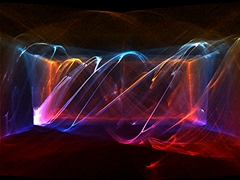Feb 24, 2010
Pigeon Impossible
Feb 9, 2010
Search & Rescue robot
Background:
Natural senses of both human and animal rescue personal are limited by range. Vision, auditory and olfactory senses heave served these teams well over the years, but as complex crisis’s, such as the earthquakes in Haiti, the Connecticut gas explosion and the constant fear of terrorist attack, become more labor intensive for search and rescue, human effort needs to be focused on concentrated areas where relief is critical. The elimination of ground teams is essential to expedite emergency response. Their replacements would be highly sensitive, aerial reconnaissance robots that quickly assess situations using AI perception to determine the most effective course of recovery.
I intend to concentrate on the sensory elements of the vehicle. Particularly I’ll focus on its perception of vision (and how it alternates through various spectrum views at different altitudes and environments); its atmospheric filter, for gauging oxygen versus dangerous vapor concentrations; its sonar and feedback for auditory and proprioception; and, lastly its power source and internal mechanics to charge functionality. Each of these characteristics will be demonstrated through the disaster situation presented in the animation. This will be a recovery exercise in which the robot (or perhaps several) coordinates an effort to establish contact with survivors and charts a rescue approach to save them.
Scene 1.1: Opens with aerial view of a remote chemical refinery at dawn. The camera first sees the sky scraping, cylindrical smoke stacks billow out think plumes of smoke over the surrounding tree line. Next it pans over workers strolling along catwalks to other ends of the station with trucks loading and unloading deliveries in the background. Everything feels like just another early morning.
Scene 1.2: We transition to a hallway where, from a worm’s eye view, employees are talking in the background near a vending machine. In our foreground is a pipe leading from ceiling to floor with a broken/leaky release valve. When we see a cigarette butt drop in front of our picture plane followed by a sudden flash of light.
Scene 2.0: Our refinery is not without hope. The explosion set off an emergency response signal triggering the release of the Emergency Assessment Reconnaissance Vehicle (EARV) from the fire station on base.
Scene 2.1: The protective hatches to EARVs shelter and repowering station lift back. The warm yellow sun piercing the timberline casts crisp shadows along its small, sleek body. We pan over its form from nose to tail while the whirl of its rotors can be heard. The pan stops overlooking the tail and the back of EARV, which is directly inline with explosion in the distance.
Scene 2.2: A below view of the EARV as it gradually takes over from its platform. Which then cuts to an ¾ aerial view of it as descends toward the explosion site that’s shrouded in black smoke.
Scene 2.3: A first person perspective of the EARV as it approaches the site. In order to visually cope with the new smoke in the atmosphere the EARV must change views. What starts as a clear picture of our scene, turns over to a thermal scan mode where hotspots are perceived in warm colors and white due to their degree of intensity, and everything else dark blue or black. We can see some distinguished shapes of bodies, which it counts and calculates position, and the core of fire inside the small hall-space where it detects no survivors.
Scene 2.4: EARV flies down for a closer view. We cut back-and-forth between a close-up of its superficial eye and its personal perspective while it assesses structural integrity of the plant’s damaged area. The camera follows it closer to survivors to assess the oxygen ratio in that area and filters audio to hear the survivors breath and moan.
Scene 3.0: While it’s assessing everything in view, a posterior sonar sensor picks up something from behind. A pipeline is collapsing directly over the aerial robot. As the pipeline begins to fall a wavy pattern appears around the EARV detecting peripheral movement and dives out of harms way.
Scene 3.1: Another shot of the personal view assessing structure.
Scene 3.2: As the EARV prepares to ascend from the site, it sends a remote signal to the approaching rescue vehicles to inform them of its findings. The EARV assessments will better prepare the emergency response crew about where to focus their attention by locating survivors, avoiding areas of structural weakness and knowing what kind of protective clothing and masks to wear.
Materials and Lighting:
Due to the complexity of the scene and all the elements involved I plan to use a variety of simple materials and lighting, and plenty of postproduction. Certain objects will receive more attention, such as the EARV, cigarette, and important elements of the chemical plant. There will be no bump maps; only color texture maps. Lighting will use the physical-sun shader with limited Final Gather and Global illumination. Character animations will remain simple since they’re either be obscured by depth or by the EARV’s vision.
In postproduction different effects will be used. Compositing different elements together; color hue shifts and illustrated elements will be brought into the scene, such as the assessment of structural integrity; and using alphas to make a rippling effect for the sonar. Plus, glows, depth blurs etc.
Resources:
I’ve looked into a number of difference sources for both realistic rescue vehicles and science fiction vehicles to use as a basis for my robot to make a reasonable, purposeful design. Additionally I’ve research chemical plant environments.
Attached are some images, video and links below.
Here are some links:
1. A chemical plant

2. Another chemical plant

3. Chemical plant at dusk

4. Chemical plant explosion

5. Generic chemical plant exterior

6. Terminator Hunter Killer
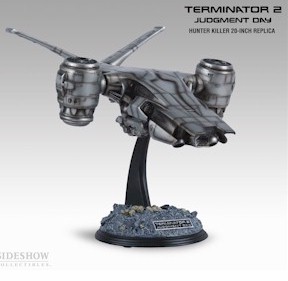
7. Example of thermal vision

8. Rescue robot
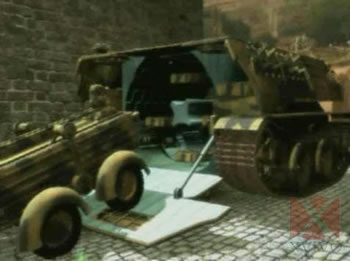
9. "Living with robots" (at 01:41)
10. CRASAR--Center for Robot Assisted Search & Rescue
11. Non-aerial designs
12.DOD: Darpa
Proposal: Below Knee Amputation - Surgical Animation for Final Project
I wish to create this animation from the perspective of the surgeon, as though it is the viewer’s hands performing the procedure. The environment will be modern, sterile and bright as it is in an operating room. The materials will be metals (the OR table and all of the surgical instruments), rubber (the surgeon’s gloves) and cloth (drapery and surgeon’s scrubs) with subsurface scattering material for skin, dielectrics for the blood, and materials yet to be determined for bone and muscle (something glossy and wet looking).
I would very much like to create something with clean models; I do not want to create an incredibly bloody scene with spatter and shredded muscle, but rather a clean scene with minimal blood and text-book clean muscles in such a way that the anatomy being manipulated in the animation can easily be identified by the viewer. I am going for a realistic but clean look. In a perfect world I would like to focus not only on creating beautiful textures for this animation but also on the realism of the physics behind cutting and manipulating different tissues. With time constraints I have chosen to focus more heavily on creating realistic physics, and hope to have the time to infuse a bit of good texturing. I will stick with Maya to do all of my modeling, as I have found good tutorials for foot, leg and hand modeling. Obviously these models will need to be rigged, and Maya Muscle will be used to help create the realism behind the tissue manipulation. If necessary, motion capture may be used to help animate the fine motor movements of the hand during certain surgical manipulations. The surgical instruments will be modeled in Maya as well, and nCloth will be used to simulate the drapery and to clothe the surgeon’s hands in latex gloves.
As is appropriate for any kind of instructional video, narration will be necessary. Also, as the actual operation takes a total of thirty minutes to an hour, steps will be shortened and spliced together in After Effects in order to make this animation the appropriate length.
The following is exactly what would need to be animated in order to depict a below knee amputation: The procedure will start with a physical examination of the uncovered, affected leg to be operated on. A cloth will be placed around the gangrenous area. The surgeon will move on to drawing incision marks with a marker along the sides and circumference of the leg. Then, the actual incision is performed along these marks with a scalpel. An electrocautery device is used to cut through the anterior and lateral muscles. An anterior vascular bundle is ligated to prevent bleeding. Then scrapers and retractors are used to pull back tissue from the tibia and fibula. A reciprocating saw is used to separate the tibia and a bone cutter is used to section the fibula. The only remaining tissue attaching the leg to the body, at this point, are posterior muscles that are quickly sliced through with a scalpel in a downward, curved fashion. The gangrenous leg is at this point completely detached from the body and is quickly removed from the operating area. The sectioned arteries poking out of the freshly sliced posterior muscles are quickly clamped to prevent bleeding out, and then the posterior tibial nerve is divided via the Guilltine technique, causing the nerve stump to retract within the muscle mass. In the same manner, the sural nerve is divided. The surgeon bevels the end of the tibia with the reciprocating saw and then rounds the bone carefully with a fine rasp. The hanging posterior skin and muscle flap is tailored with a scalpel to remove excess muscle that would get in the way of closing the flap. The surgeon then lifts the flap up and around to meet the front of the leg. Holding the flap in this closed position, the surgeon staples the wound closed and then supplements this closure with stitches. The operation at this point is complete and this would be the end of the animation.
1. Reference from XVIVO Scientific Animation. I would love to accomplish this level of realism in the modeling of the foot and leg.
2. Reference from Argosy Medical Animation. I like the sterile environment and the subtle use of cloth folding, as well as the surgical basins in the background detail.
3. Reference from Radius Medical Animation. The use of extreme close-ups such as this is something I’d like to incorporate. Unfortunately, due to time constraints, it may be difficult to render out an entire animation with the use of depth of field, something I would really prefer to be able to do.


Feb 8, 2010
Le Fort I Osteotomy - Final Project Proposal
Background:
Maxillary osteotomy is performed in an extremely vascular region where bleeding control is frequently not possible until completion of the procedure. To minimize damage, and understanding of the blood supply to the mobilized maxilla is crucial. In medical textbooks that illustrate this procedure, few have shown the structures that lie in the region where the cut is made. A surgeon’s knowledge of this area comes from reading through copious amounts of textbooks and research papers.
The overall aim will be to focus in on anatomical structures that are hidden to the surgeon’s eye whilst doing the operation. Therefore, as a result, surgical residents viewing this animation will have a better idea of the vessels, nerves, and tissue that are located around the areas that will be sawed.
There are many components to this animation that need to be addressed. First of all, the models will have to be anatomically correct in order to give the best visualization of the maxillary region of the skull. I already have a skull model that was taken from a patient’s MRI scan, however this will need to be cleaned up and refined as there are a few missing chunks of bone in the model – something that could be better done in zBrush. Anatomical features such as vessels, soft tissue, and nerves will have to be modeled by hand and reviewed by a content advisor. My main collaborator on this project will be a surgeon from the Craniofacial center. He will assist in making sure the content and movement of the surgical instruments, and procedure, are correct.
Below is a mockup of a possible color concept for the finished piece and some sketches from the storyboard:






As for the patient’s face I was thinking of a realistic model with simple texturing applied to it, similar to a glass person so that the underlying anatomy is emphasized.
Additional to the human model, surgical tools will be constructed and given a realistic texture. The movements and handling of the tools will be animated as an additional reference for viewers.
This animation requires a lot of post-production in addition to a spoken narration and possibly background music. I’ve already written out a script, which was taken mostly from papers I’ve found on the procedure. In post-production a lot of fading and overlaying to give it the effect I would like to work towards. This will be done in After Effects and Premier Pro.
Scorpion Attack - Final Project
Scene 1
Starting with a “technical” animation: the scorpion will be shown in a lateral view, and rotated to show all sides. The background will be a grid, to emphasize the technical concept. Data will be presented on the screen relating to the name, genus, species, location, poisonous, etc. It will be “typed” on the screen at a rate fast enough to not dwell on it, but slow enough to be read. The rotating scorpion will be done in Maya, while the rest of this scene will be done in After Effects.
Transition
Showing a globe of the Earth revolving and slowing on North America. Then, there will be a zoom in to southwest United States and Mexico, with a label at the top stating this is the region where these scorpions are found. A boundary will be overlaid to note the exact region. Then a “warp zoom” will be performed in to the next scene.
Scene 2
This scene will show the scorpion in its walking cycle. This particular scorpion is unique in that it is the only one that can climb on semi smooth to rough surfaces. The scorpion is found in riparian areas - moist, wet areas along rivers amid arid regions. It will be crawling out from underneath a piece of wood/bark, along the ground, then on top of the piece of wood/bark.
Transition
The camera will pan with the scorpion’s movement to bring the prey in to the view. Scenes 2 and 3 will basically be a continuous shot.
Scene 3
The scorpion will attack another insect, most likely a cricket, as they are a staple of this species’ diet. The scorpion will dance around the unsuspecting cricket, and then grab it with its pincers. The tail will then come forward and sting the prey multiple times.
Transition
Again, a warp zoom will be used to cut between the scenes. The zoom will begin zooming in on the tip of the tail, and then it will accelerate. The final destination will be a cross section of the stinger.
Scene 4
Showing the telson (stinger) will be shown injecting the venom from a cross section. If adequate information allows for me to create an accurate representation, I would like to show how the specific muscles involved with venom injection work. This species of scorpion can regulate how much venom is injected with each sting via muscle control, as opposed to other animals such as snakes, which cannot.
Materials and Lighting
The goal of this animation will be to create a realistic environment and subject matter. The exoskeleton of a scorpion is consistent with a blinn material, but I will have to do some more research and see if I need to take in to consideration some subsurface scattering. That will increase render times, but it will add to the realism. The environment will utilize image mapping, bump mapping and so on. To simulate an outdoor scene, a directional light will be used to simulate the sun. However, a riparian area is known to have a lot of tree coverage, so a silhouette of leaves and branches will be mapped in to simulate a tree-covered environment. Supplemental lights will be added in as necessary to illuminate dark areas, or enhance reflected lights.
Resources
Various images of Arizona Bark Spider have been collected. These will be used to aide modeling and texturing. Videos of scorpions in motion are being collected to ensure the walk motion is accurate. Along those lines, the attack sequence needs to be accurate, so videos of that action are also being collected. The scorpion will be rigged with a skeleton. This will be a challenge, as there are very few tutorials or guides on rigging octopeds. This will be accomplished by research and trail & error. To start, I will rig mock ups to test before putting a lot of effort in to the modeling and texturing. Environmental images are in the process of being collected to help model and texture the environment to enhance realism.
Some of the resources I have collected so far are as follows below:
Final Project Proposal
Final Project Proposal
I am not quite set yet on what I want to do for my final project. Ultimately, I feel like I’ll start to figure out what direction I want to go we build upon our lessons from each class. I am still relatively new to Maya so the more I learn and becoming comfortable with the different skill sets will help me narrow down my project. As of now I have two ideas for my final, one still pretty vague and the other a bit more detailed. My first idea is kind of like a continuation of our first assignment. I want to create a creature, or creatures, and have them interact with their environment, which will be set on a fairly alien world. I still need to work out a story for this but I would like to introduce these little, simple creatures who go about their day in a jungle like setting, and end the scene with the introduction of a larger creature who strikes fear in the other.
Another idea is to create a story about a ghost in a haunted house. I had the idea of using a ncloth to be a sheet draped over an invisible presence and have it interact with the house or possibly neighborhood. I have the image of doing a scene where the ghost goes through a wall but once the sheet hits it, the sheet collides and falls to the ground. I’ll have to develop a story for it but the character and setting are almost figured out.
My other idea is to incorporate a ancient stories and myths. I recently saw the movie The 4th Encounter or The 4th kind (I forgot what it was called), but it dealt with aliens and the ancient Sumerian belief in ancient astronauts. I kind or what to model out this story and depict aliens coming to earth and interacting with ancient man, or cave men. I’d model planets, spaceships and an area with caves. I think it might be a lot but it be cool to plan this all out.
I’ll need to do more research on what’s been done already or works in
similar vein cause I haven’t seen many example yet.
Update
After thinking about what I want to do for my final project, I’ve decided to go with my ancient alien idea. I plan to use the Sumerian story of ancient astronauts visiting earth and create an animation that helps introduce the story. Currently I have 3 scenes planned out to make my animation work.
The first scene will show the solar system with all the planets and an additional alien planet, Planet X, that will have a more elongated orbit. I want to animate the planets’ orbits around the sun and have a voice over explaining Planet X. This will then lead to a space ship coming from Planet X heading for Earth. This scene should be fairly easy as the only materials I’d have are spheres with different shaders to make them look likes their planet counter parts. I’d also probably use a dome filled with stars as a backdrop to help create the feeling of the vastness of space.
The second scene would be a more close up shot of the spaceship traveling from its planet to earth. This scene would focus more on the ship and I would need to create a very metallic looking craft.
The third scene would depict life on earth through the eyes of the men on earth, most likely cavemen. This scene would be the most difficult as I would try to create a prehistoric earth. I envision a desert or jungle or possibly a combination of both environments as my main set. There would also be a cave nearby which the cavemen would retreat to once the spaceship comes in to view and lands near it.
A very quick summary on the Sumerian gods theory
Planet X's orbit

Sketch of ship flight
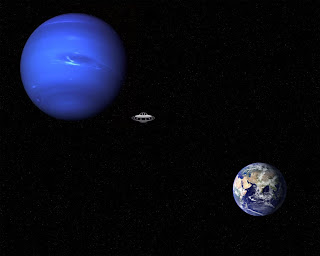
Ship flight animation by unnamed artist
Image of earth with giant planet in the sky found with google
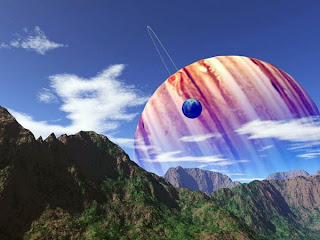
Caveman by Craig De Leenheer
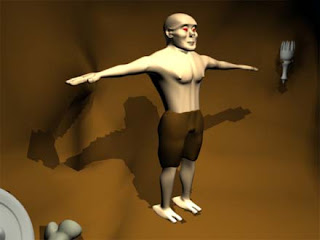
When Hunger Strikes by Ilan Gabai
"Ancient Astronauts II" by Tuomo Antero Kakkonen

Feb 4, 2010
final project proposal
My final project for this class it will be basically a video footage with CG-based elements that interact with the scene objects.
The main location is a science/chemistry laboratory that conducting research about new and unknown elements. They basically test the elements, and they put them into proper types of containers to keep them safe in case of dangerous behavior.
The story is divided in three main scenes:
First scene:
In the operative lab there is no human presence, only mechanical arms are allowed to interact with the materials. In the laboratory everything is clean, there are plastic and glass material and also metals, like aluminum and steel.
The visual reference about this chapter are the Bjork’s video music “All is full of love” directed by Chris Cunningham. For the color skin, materials, and slow movement of the mechanical parts.
For the reaction of materials the reference is the work of Vaclav Pajktr a Czech graphic designer, 3D “abstract artist” Some examples of his works are on his website: http://www.projekt0.net/index2.html
In this first scene, everithing is made in CG.
Second scene:
The materials are stored and classified in an archive, placed in the basement of the laboratory. This archive has also a plain texture, but not clean as well as the operative lab.
Into the room there is a big table, with a tiled surface and metal boundaries. On one side there is a door, a big security door, with mechanical visible (from the inside) parts and simple electronic security devices. On the other three sides of the room there are big solid shelves with some containers on. The containers has different shapes: they could be like a cage, or like a jar, but the most common is one made in glass with metal rough edges, closed with big nuts and screws. In this kind of container, the lab put the most dangerous and reactive material. The room is made by reinforced concrete walls, and has a high ceiling. From the ceiling comes down some electrical wires of for the neon lamps that enlighten the room.
Someone bring another cage into the archive and leave it on the big table, than exit and turn of the main light. The element into the cage starts to react, trying to break the glass cage. From the corridor, outside the room is possible to see some light leaks.
the corridor will be filmed from a real one, with visible and colored pipes and concrete walls.
Third scene:
outside of the building the “bad” material succeed in his escape and go outside of the building where it interact with parked cars. The material is basically a rubber element, changes his color and size, until it becomes a big rubber ball.
At this point the video has a “viral” style, like the video “apple” (http://www.youtube.com/watch?v=2V5fKX_U3qY) from The Mill creative studio. http://www.the-mill.com/
Final Project Proposal
The theme of visual music has been of much interest to me and is essentially what I aim to explore with this project, with the works of artists like Jordan Belson, James and John Whitney, Oskar Fischinger, Norman McLaren, Richard Baily, and Joost Rekveld having been of much influence to me. I don't want to make a music video, nor do I want to make something easily pigeon-holed as psychedelic or new-age - but inevitably the correlation will be made.
This will certainly be a stretch for me considering at this point I know nothing about MEL scripting, if Maya's physics engine will even render cymatic forms, if I can devise algorithms in MEL or Python for systems of emergence/self-organization, or if I can even do any of this without it coming off as empty eye-candy... but these are aspects of Maya that I am truly interested in, so I'd like to spend the semester exploring them.
Artists of Influence
Joost Rekveld
Sketches/Current/Parallel Works
Feb 3, 2010
final project proposal
Final Project Description
For my final project, I do not have an absolute clear idea of what I want to do, but I am sure of several aspects of the project. First off, the piece will focus on several topics- high-res modeling, advanced photorealistic texturing, and good character animation. I want to model at least one, if not more than one, complex character in zBrush, export that character to Maya and animate it. The modeling itself will most likely be stylized, perhaps in a caricature or juxtaposed (I hate that word) creature mash up. The textures, however, I want to be as photorealistic as possible. I always liked exploring the idea of a completely impossible creature in an impossible environment that is still convincing based on its realistic appearance.
As for the actual setting, story, environment etc, I could go one of two ways. One concept I could follow is, for lack of a better word, a metaphysical type of setting with elements that are beyond the scope of traditional physical understanding. I have been playing around with a Greek mythology creationist type piece, drawing on the myths of the Titans. I wanted to do an outer space type of scene with a being so large that it was interacting with the planets, creating and manipulating time and space itself… but without being really, really, really cliché. I feel like using motifs like time has become extremely stereotypical. But I would want to do something surreal, but still sticking to plausible and realistic things, like realistic anatomy and subtle skin tone shaders etc. The other approach would be to do something in the vein of a one liner joke, but in animation form somehow. I don’t often see this sort of thing, which is what compels me to do it.
Some ideas I have had lately-
Pool shark- a crowded pool bar where in one of the pool tables the felt starts rippling like water and a shark explodes out of the table and starts thrashing around destroying things, and the felt of the table would turn to the consistency of water.
Jurassic Park- a couple of close shots of some velociraptors swinging around and it zooms out to them innocently swinging on swing set with piles of remains all around them, possibly with torn up children’s clothes.
Fish n chips- a goldfish driving down the highway being pulled over by two highway cops
Captain Mexico- this one might be in bad taste… but instead of having captain America, I wanted to have captain Mexico’s story told, where instead of being all heroic and fighting crime he is working as a fry cook in some fast food joint. Or a janitor. But this one probably wouldn’t go over too well.
In the end I will probably end up trying to do a surrealistic scene that still tells a story. What that narrative is exactly, I haven’t figured out though. I will toss around the Greek mythology idea for a bit and see if I can come up with a solid narrative that would be plausible to accomplish within the given time frame. I am also considering using my character from last semester’s final and incorporating it as one element, perhaps a man vs. machine mythos, but again I am trying not to make something that has been so overly done before. Plus I would like to have something original for use in my portfolio. But I will consider it nonetheless.

















